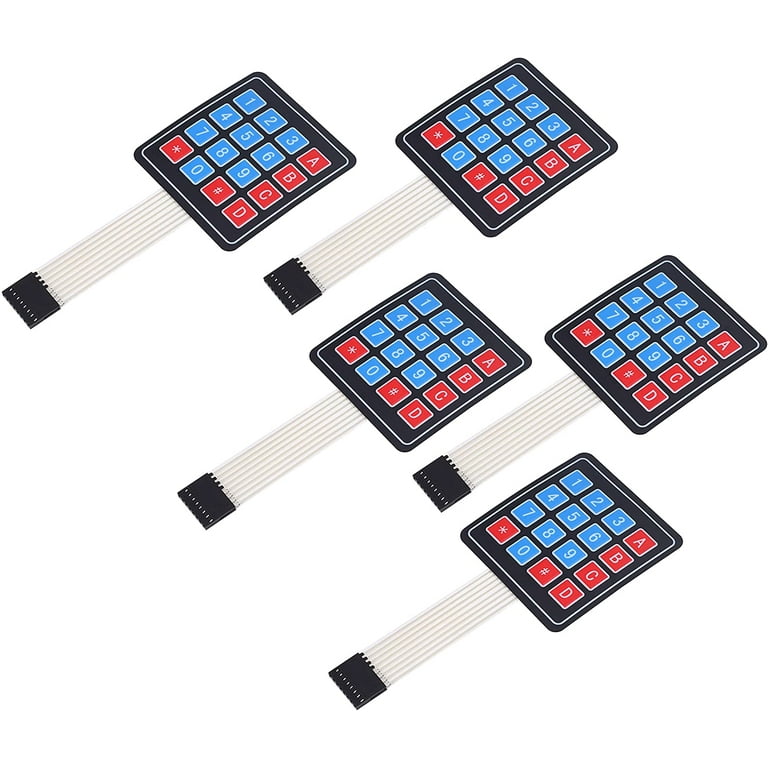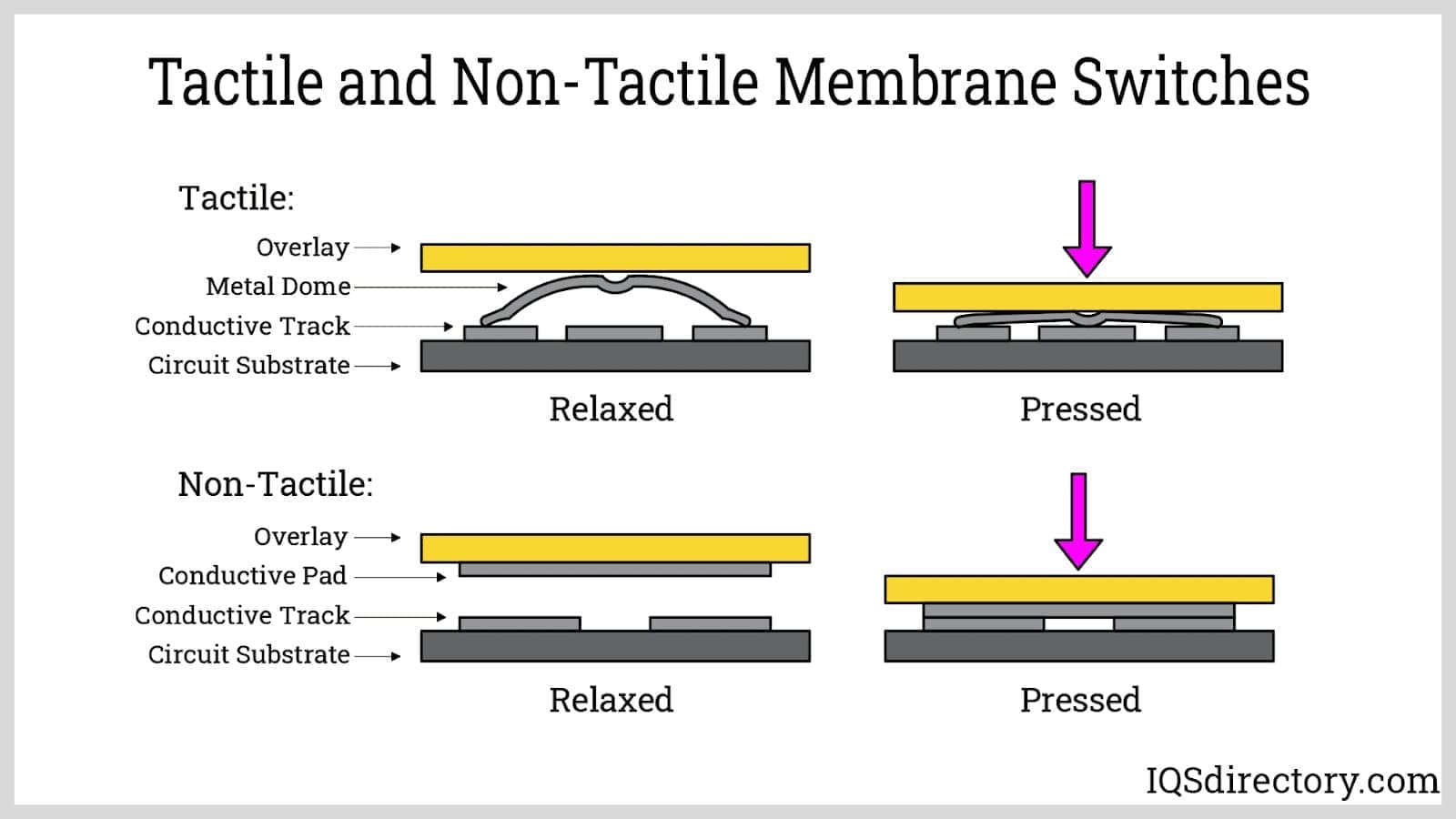Membrane Switch Manufacturer Delivering Completely Tailored Solutions
Membrane Switch Manufacturer Delivering Completely Tailored Solutions
Blog Article
Understanding the Relevance of Membrane Switch in Modern Electronic Devices and Their Applications
Membrane changes work as a necessary component in contemporary electronic devices, providing a reliable interface for individual communication. Their light-weight and customizable nature makes them ideal for a variety of applications across varied sectors. Understanding their crucial parts and advantages can offer understandings right into their growing importance. As innovation proceeds to advance, the evolution of Membrane changes elevates questions about their future applications and design advancements. What exists in advance in this vibrant field?

What Are Membrane Switches?
Membrane switches are important parts in contemporary electronic devices, working as interface that help with communication in between devices and customers. These switches are composed of numerous layers, consisting of a visuals overlay, a glue layer, and a circuit layer, all of which collaborate to produce a resilient and useful interface. The design enables a level, low-profile solution that can be personalized pertaining to size, form, and visual look, making them ideal for different applications, from customer electronics to medical tools. The tactile comments provided by Membrane changes enhances individual experience, while their resistance to dirt and moisture makes them suitable for testing environments. In addition, Membrane switches can integrate attributes such as backlighting and printed graphics, additionally increasing their usability. Their flexibility and effectiveness make them a recommended choice in industries where dependability and convenience of usage are paramount, ultimately adding to the smooth procedure of modern-day digital tools.
Key Components of Membrane Switches Over
While numerous components add to the functionality of a membrane switch, three main layers play considerable functions in its style and procedure. The leading layer, commonly made from a sturdy polymer, acts as the user interface for user interaction, typically featuring printed graphics and icons. Below this is the spacer layer, which preserves the required distance between the top layer and the circuit layer. This spacer layer warranties that the button turns on just when pushed, stopping unexpected inputs. The circuit layer has conductive traces that finish the electrical circuit when the top layer is depressed. These traces can be made from numerous products, consisting of copper or silver. Together, these components develop a trusted and durable tool that is small and functional, appropriate for a variety of electronic applications, from home appliances to clinical gadgets. Comprehending these key parts is crucial for appreciating the total capability of Membrane buttons.
Benefits of Using Membrane Changes

Membrane Switch Manufacturing Refine
Comprehending the Membrane switch production process discloses the elaborate actions associated with generating these necessary components. The procedure normally begins with the style phase, where designs and requirements are created making use of specialized software. Following this, the visuals overlay is published on a flexible substratum, often utilizing high-resolution printing strategies to guarantee clearness and precision.Next, the sticky layers are applied, which offer to bond the various parts together. The circuit layers, made from conductive inks or products, are after that printed onto a separate substratum. These layers are carefully lined up and laminated flooring to create a practical switch.After setting up, the buttons go through examining to verify performance and durability. Quality control procedures are applied throughout the process to identify and correct any type of flaws. The completed Membrane switches are packaged and prepared for distribution, ready to meet the demands of modern electronic applications.
Applications of Membrane Changes in Different Industries
Membrane switches are progressively used across different markets, especially in medical devices and consumer electronics. In the medical area, they give reliable control interfaces for tools that call for specific procedure. In a similar way, in customer electronics, these switches enhance customer communication by using smooth and responsive user interfaces.
Medical Tools Control
Countless contemporary medical devices make use of Membrane switches for structured operation and enhanced customer communication. These switches give a trusted, long lasting user interface for a range of applications, including analysis devices, patient surveillance systems, and surgical tools. Their adjustable designs permit for certain layouts that can suit the distinct demands of health care professionals, making certain user-friendly navigation and reliable access to essential features. Additionally, Membrane buttons are resistant to impurities, making them appropriate for clean and sterile atmospheres. The responsive comments they supply can enhance customer self-confidence, minimizing the danger of mistakes throughout crucial clinical treatments. In general, the assimilation of Membrane switches in clinical equipment considerably contributes to enhanced company website functional efficiency and client safety and security in healthcare setups.
Customer Electronics Interfaces
In the domain of customer electronic devices, Membrane switches play a critical role in improving customer interfaces throughout a wide variety of tools. These switches are essential to items such as remotes, microwaves, and pc gaming consoles, offering a effective and straightforward interface. Their style permits a smooth assimilation of graphics and capability, enabling makers to develop streamlined, modern aesthetic appeals without endangering use. Membrane buttons are additionally recognized for their resilience, typically standing up to substantial usage and direct exposure to numerous ecological problems. In addition, they can integrate functions like backlighting and tactile comments, additional improving the user experience. As consumer needs for innovative yet instinctive user interfaces expand, Membrane switches continue to be an important component ahead of time digital tool performance.
Style Considerations for Membrane Switches Over
Creating efficient Membrane switches needs careful attention to numerous aspects that influence both functionality and customer experience. One crucial consideration is the choice of products, as they can influence longevity, responsive responses, and aesthetic appeal. Picking an appropriate adhesive is necessary for guaranteeing long-lasting bond and resistance to ecological factors.In enhancement, the design and style of the button should suit individual interaction, with switch sizes and spacing optimized for convenience of usage. The consolidation of graphics linked here and labeling should focus on clarity and presence under numerous lighting conditions.Consideration of electric qualities, such as actuation force and button sensitivity, will boost the responsiveness of the Membrane button. The design must accommodate making procedures to guarantee cost-effectiveness and prompt manufacturing. On the whole, a well-balanced style boosts both the performance and the user experience of Membrane switches in contemporary electronic devices.

Future Fads in Membrane Switch Modern Technology
As innovation remains to advance, Membrane buttons are poised to incorporate brand-new improvements that will enhance their capability and application in different fields. One considerable pattern is the unification of resilient and adaptable materials, which will certainly enhance the life expectancy and integrity of these buttons. Enhanced surface area appearances and adjustable graphics are likewise expected, enabling even more user-friendly individual interfaces.Moreover, the assimilation of clever innovation, such as touch-sensitive surface areas and haptic feedback, is check out this site expected to boost user interaction, making Membrane switches over a lot more receptive and interesting. Furthermore, advancements in published electronic devices will make it possible for extra complex wiring within thinner accounts, better broadening style possibilities.Sustainability will also play a crucial duty in future advancements, as makers check out green materials and manufacturing processes. On the whole, these fads will certainly assure that Membrane switches over continue to be pertinent and important in an interconnected and progressively electronic world.
Frequently Asked Questions
Just How Do Membrane Switches Contrast to Standard Mechanical Switches?
Membrane changes deal benefits over traditional mechanical buttons, including reduced size, lighter weight, and boosted sturdiness. They usually offer a secured surface, enhancing resistance to dirt and wetness, making them excellent for diverse applications.
What Materials Are Frequently Made Use Of in Membrane Switch Construction?

Can Membrane Switches Over Withstand Extreme Environmental Conditions?
Membrane buttons can endure extreme ecological problems, relying on their layout and materials. Top notch buildings frequently feature toughness versus temperature level fluctuations, moisture, and exposure to chemicals, making them appropriate for different demanding applications throughout industries.
How Much Time Do Membrane Switches Commonly Last Prior To Failure?
Membrane switches usually exhibit a life expectancy varying from 1 to 10 million actuations, depending on factors such as usage frequency, ecological conditions, and making high quality. Regular upkeep can extend their toughness and functional integrity substantially.
Are Membrane Changes Customizable for Details Applications?
Membrane buttons are without a doubt personalized for specific applications. They can be customized in style, capability, and size, enabling manufacturers to fulfill special user demands and enhance product appearances while keeping functional performance and toughness. Membrane switches are vital components in modern-day electronics, offering as customer interfaces that help with communication between tools and individuals. The responsive comments provided by Membrane switches over boosts customer experience, while their resistance to dust and moisture makes them optimal for testing environments. The incorporation of graphics and labeling should focus on clarity and visibility under different lights conditions.Consideration of electric characteristics, such as actuation pressure and button level of sensitivity, will improve the responsiveness of the Membrane switch. Boosted surface appearances and customizable graphics are likewise expected, enabling for even more user-friendly customer interfaces.Moreover, the integration of smart innovation, such as touch-sensitive surface areas and haptic comments, is expected to enhance user communication, making Membrane changes extra receptive and interesting. Membrane switches over deal benefits over standard mechanical buttons, including lowered dimension, lighter weight, and enhanced sturdiness.
Report this page